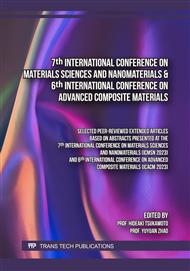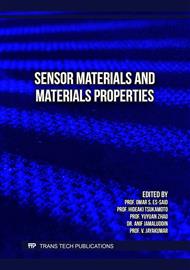[1]
A. Ahmed et al., "Additively manufactured nano-mechanical energy harvesting systems: advancements, potential applications, challenges and future perspectives," Nano Convergence, vol. 8, no. 1. Korea Nano Technology Research Society, Dec. 01, 2021.
DOI: 10.1186/s40580-021-00289-0
Google Scholar
[2]
Y. Tang et al., "Electrospun Nanofiber-Based Membranes for Water Treatment," Polymers, vol. 14, no. 10. MDPI, May 01, 2022.
DOI: 10.3390/polym14102004
Google Scholar
[3]
A. A. Shah, J. Yang, T. Kumar, C. Ayranci, and X. Zhang, "Synthesis of transparent electrospun composite nanofiber membranes by asymmetric solvent evaporation process," Colloids Surf A Physicochem Eng Asp, vol. 666, p.131264, Jun. 2023.
DOI: 10.1016/j.colsurfa.2023.131264
Google Scholar
[4]
A. Mamun, T. Blachowicz, and L. Sabantina, "polymers Electrospun Nanofiber Mats for Filtering Applications-Technology, Structure and Materials," 2021.
DOI: 10.3390/polym13091368
Google Scholar
[5]
A. Al-Abduljabbar and I. Farooq, "Electrospun Polymer Nanofibers: Processing, Properties, and Applications," Polymers, vol. 15, no. 1. MDPI, Jan. 01, 2023.
DOI: 10.3390/polym15010065
Google Scholar
[6]
D. H. Reneker, A. L. Yarin, E. Zussman, and H. Xu, "Electrospinning of Nanofibers from Polymer Solutions and Melts," Advances in Applied Mechanics, vol. 41, 2007.
DOI: 10.1016/S0065-2156(07)41002-X
Google Scholar
[7]
T. Blachowicz and A. Ehrmann, "Conductive electrospun nanofiber mats," Materials, vol. 13, no. 1, 2020.
DOI: 10.3390/ma13010152
Google Scholar
[8]
J. Xue, T. Wu, Y. Dai, and Y. Xia, Electrospinning and Electrospun Nanofibers: Methods, Materials, and Applications, Chemical Reviews, vol. 119, no. 8, p.5298–5415, 2019.
DOI: 10.1021/acs.chemrev.8b00593
Google Scholar
[9]
F. Mokhtari, Z. Cheng, R. Raad, J. Xi, and J. Foroughi, "Piezofibers to smart textiles: a review on recent advances and future outlook for wearable technology," J Mater Chem A Mater, vol. 8, no. 19, p.9496–9522, 2020.
DOI: 10.1039/d0ta00227e
Google Scholar
[10]
Z. Yang, C. Wang, and X. Lu, Nanofibrous materials, no. 2005. Elsevier Inc., 2018.
DOI: 10.1016/B978-0-323-51270-1.00003-0
Google Scholar
[11]
Y.Dahman, K.Deonanan,T.Dontsos, A.Iammatteo, Chapter 6: Nanopolymers. In Nanotechnology and Functional Materials for Engineers; Dahman, Y., Ed.; Elsevier: Amsterdam, The Netherlands, (2017) 121–144. doi: 10.1016/b978–0-323–51256-5.00006-x.
DOI: 10.1016/b978-0-323-51256-5.00006-x
Google Scholar
[12]
R. Vasita and D. S. Katti, "Nanofibers and their applications in tissue engineering," Int J Nanomedicine, vol. 1, no. 1, p.15–30, 2006.
DOI: 10.2147/nano.2006.1.1.15
Google Scholar
[13]
C. Duff, A. Rowland, A. Long, and Y. Wu, "Fabrication and Characterization of Optically Transparent PVDF Films Embedded with Gold Nanoparticles," 2021.
DOI: 10.21203/rs.3.rs-1105202/v1
Google Scholar
[14]
Y. Xiao, H. Luo, R. Tang, and J. Hou, "Preparation and applications of electrospun optically transparent fibrous membrane," Polymers, vol. 13, no. 4. MDPI AG, p.1–29, Feb. 02, 2021.
DOI: 10.3390/polym13040506
Google Scholar
[15]
K. Lazarova, S. Bozhilova, S. Ivanova, D. Christova, and T. Babeva, "Flexible and transparent polymer-based optical humidity sensor," Sensors, vol. 21, no. 11, Jun. 2021.
DOI: 10.3390/s21113674
Google Scholar
[16]
B. Jaleh and P. Fakhri, "Infrared and Fourier transform infrared spectroscopy for nanofillers and their nanocomposites," in Spectroscopy of Polymer Nanocomposites, Elsevier Inc., 2016, p.112–129.
DOI: 10.1016/B978-0-323-40183-8.00005-7
Google Scholar
[17]
S. K. Karan, D. Mandal, and B. B. Khatua, "Self-powered flexible Fe-doped RGO/PVDF nanocomposite: An excellent material for a piezoelectric energy harvester," Nanoscale, vol. 7, no. 24, p.10655–10666, Jun. 2015.
DOI: 10.1039/c5nr02067k
Google Scholar
[18]
N. Shehata et al., "Stretchable nanofibers of polyvinylidenefluoride (PVDF)/thermoplastic polyurethane (TPU) nanocomposite to support piezoelectric response via mechanical elasticity," Sci Rep, vol. 12, no. 1, Dec. 2022.
DOI: 10.1038/s41598-022-11465-5
Google Scholar



